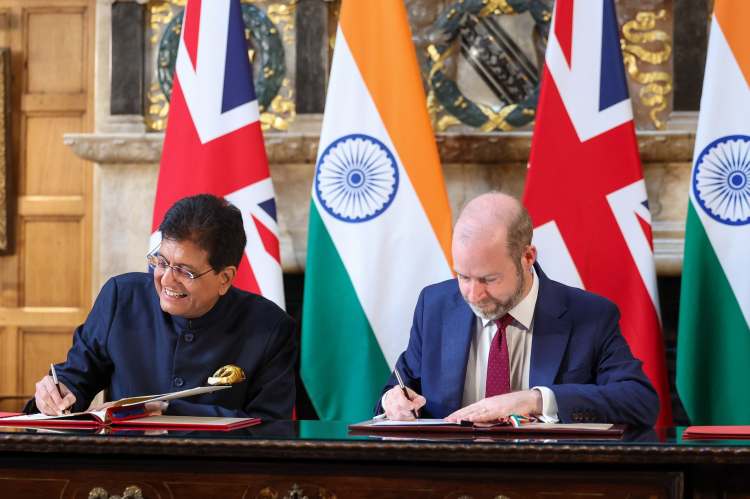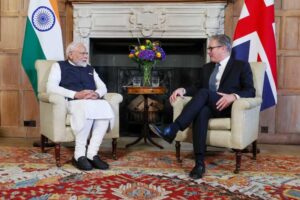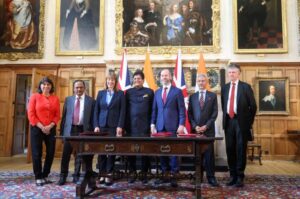
India-UK FTA signed: The India-UK Comprehensive Economic and Trade Agreement tears down tariffs on about 99% of India’s exports and trims duties on 90% of UK tariff lines. It embeds provisions on mobility, innovation, social security, anti-corruption and labour — chapters that go well beyond tariff schedules. As New Delhi negotiates simultaneously with the EU, Oman, Peru and Israel, this pact reads like a model contract India can now replicate, with tweaks, across negotiating tables worldwide.
The India-UK FTA recognises that India’s comparative advantage lies not just in merchandise but in people and platforms. Duty-free access for labour-intensive exports — from textiles and leather to marine products — comes with guaranteed pathways for short-term business mobility and a quota of 1,800 visas for chefs, yoga instructors and classical musicians. Equally important is the three-year exemption from UK social security contributions under the Double Contributions Convention, which cuts employment costs for Indian firms posting staff to Britain. This triangulation of goods, services and talent gives the agreement a balance absent in many earlier FTAs.
READ I A national carbon budget key to India’s net zero push
India-UK FTA: Innovation, IP and integrity
The India-UK FTA contains first-ever Indian commitments in an FTA on anti-corruption, labour rights, gender and development — signalling that India can negotiate inclusive trade without conceding on core domestic interests. It establishes an Innovation Working Group, locks in patent-process improvements and extends high-standard GI protection beyond wines and spirits. These elements answer long-standing complaints that India’s FTAs were plain vanilla tariff bargains. By anchoring transparency, good regulatory practice and digital trade norms, the pact equips Indian exporters — especially MSMEs—to navigate modern supply chains where paperwork and compliance are as decisive as price.

The UK gets phased cuts on whisky (150% to 75% immediately, 40% by year 10) and car imports (down to 10% under quotas), but India keeps sensitive tariff lines — dairy, apples, edible oils — off the table. A bilateral safeguard clause allows either side to temporarily raise duties if imports surge and injure domestic industry. That is modern flexibility, not backdoor protectionism. It signals to other partners that India will liberalise aggressively where competitiveness is strong, yet preserve policy space where livelihoods are fragile.
States and MSMEs in the frame
The India-UK FTA’s benefits spill across Indian states and sectors — grapes and onions from Maharashtra, spices from Kerala and the Northeast, shrimp from Andhra Pradesh, engineering goods from Gujarat and Tamil Nadu. MSME clusters in Agra, Kanpur, Kolhapur and Chennai gain from zero tariffs, GI recognition and simplified standards. The UK’s £38-billion annual government procurement market, newly opened to Indian bidders, lets competitive Indian firms pitch for green infrastructure, health and transport contracts. A rise in certificates of origin issued in FY 2024–25 suggests exporters are already learning to use FTAs; CETA will accelerate that trend.

Beyond chapters and schedules, India-UK FTA embeds a re-opener mechanism: if India offers better terms to another country, the UK can seek parity. India must internalise that reciprocity works both ways — future partners will ask for what the UK got. That is precisely why the India–UK template matters: it codifies India’s comfort level with deeper disciplines (digital trade, SPS, TBT, procurement) without surrendering sovereign regulatory space. Countries like the EU, with even tighter standards, will now negotiate from a clearer baseline, reducing negotiation cycles and political friction.
Much of the commentary will obsess over whisky, cars and shrimp. The real dividend lies in trust-building features — dispute settlement clarity, transparency rules, data-flow provisions, and mutual recognition pathways for professionals. These convert a tariff bargain into a durable economic relationship. For a country intent on climbing global value chains in electronics, med-tech, chemicals and clean energy, legally locked-in access and predictable rules matter more than one-off duty cuts.
Policy prescription: Codify, audit, replicate
If the India-UK FTA is the template, India needs a playbook. Three policy steps follow logically:
Codify a model FTA framework: The commerce ministry should publish a standard set of chapters — mobility, innovation, anti-corruption, gender, SME facilitation, procurement access — along with plug-in annexes for sectoral specifics. This will shorten negotiation time and improve inter-ministerial coordination.
Create a post-FTA audit cell: Benefits don’t flow automatically. A joint India–partner audit cell should track utilisation of tariff lines, visa quotas, procurement wins and SPS/TBT clearances, and fix bottlenecks quarterly. Data on certificates of origin and sectoral uptake must inform mid-course corrections.
Embed state and MSME support: A dedicated portal should bundle rules-of-origin calculators, procurement alerts, and compliance checklists. State export promotion councils must be funded to help small firms meet UK standards on SPS, labour and environment—conditions that will recur in every serious FTA henceforth.
The India-UK FTA shows India can negotiate hard on interests and still write progressive, future-ready rules. It will not be the last such agreement; it should be the first that others emulate. The challenge now is not to sign more deals, but to institutionalise a method — so that every subsequent FTA is quicker to conclude, easier to implement and harder to derail.
